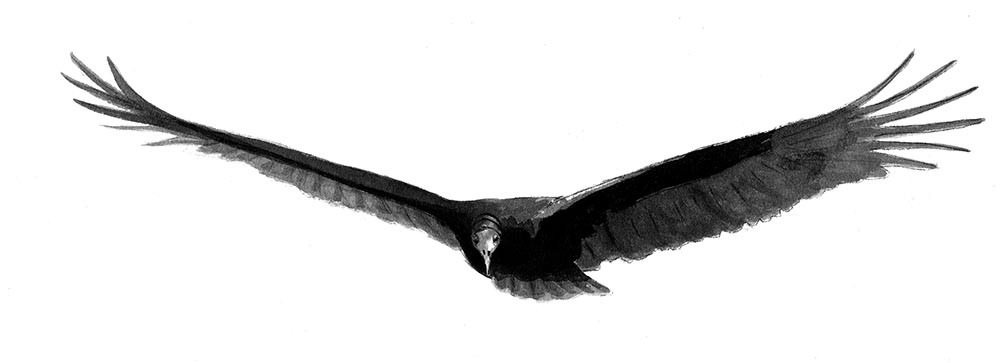
“Mom, there’s a really big crow in the compost,” my son said one day early this spring, followed closely by, “Wait. What is that bird? It’s huge!”
I peeked out the back window to find a bird, huge indeed, a red head atop of cloak of black feathers, sitting on a corner post of the garden fence, peering into the compost heap. Two others perched behind the garden, high in a tall white pine tree. The red head, naked of feathers, easily gave the birds away as turkey vultures. While we see these vultures often during the warmer months, soaring in circles high in the sky, we’d never seen them up close.
Their visit to our backyard inspired us to learn a bit about these scavengers, who lead interesting – although rather gross, at least to us – lives. (Warning: You might not want to read this while eating!)
“They’re fascinating birds, very well-adapted for their lifestyle,” said Pam Hunt, a New Hampshire Audubon avian conservation biologist.
That lifestyle includes existing primarily on a diet of carrion, vomiting as a defense mechanism, and excreting onto their own legs to cool off on hot days. Turkey vultures also have a highly developed sense of smell.
Rarely seen in northern New England before the 1970s, turkey vultures have expanded their range northward, and nesting has been documented as far north as Quebec.
Hunt noted several potential factors to the turkey vultures’ increasingly northern range: an extensive interstate road system that provides tasty roadkill, the ban of DDT in the early 1970s, and a gradually warming climate over the past few decades. Whatever the reasons, turkey vultures are now a common sight for sky-watchers during the warmer months and are easy to distinguish, even as they soar high above the ground.
“They’re huge, for starters,” said Hunt. “They’re way bigger than any hawk, more similar in size to eagles. And they’ve got this tiny little head.”
While many raptors tend to fly with wings straight across, turkey vultures’ wings form a slight V-shape, and the birds wobble from side to side a bit as they soar on thermals. The feathers closest to their bodies are dark, but the flight feathers appear lighter, almost silvery, from below. Although it’s typical for the head to be red, in fact the color is quite variable. It can be bright or dull, and may be white or blue, depending on a number of factors such as gender and level of agitation. Whatever the color of that “tiny little head,” you’ll notice it’s bald – like a turkey’s.
Baldness has a distinct hygienic advantage for a bird that often feeds by shoving its head into a carcass. In addition to feeding on large carrion such as deer and farm animals, the birds also nosh on smaller carrion – for example, rodents, reptiles and fish. They’re not picky eaters.
The birds are constrained, however, by their beaks and relatively weak talons, which prevent them from easily opening the thick skin of some carcasses. They either have to wait until some other animal tears through the pelt, or enter through softer areas – like the anus, mouth, and nostrils. They often eat the eyes and tongue of carcasses first.
Turkey vultures often find their food through scent. The birds gather in communal roosts and will set off to forage after sunrise, depending on the weather. They rely heavily on thermals to fly and may soar at an elevation of 200 feet while foraging, although they’ll go as high as 5,000 feet when migrating. In the right atmospheric conditions, they can travel miles without flapping their wings. With their highly developed sense of smell, turkey vultures can locate concealed carcasses even when they can’t see them – hidden below a forest canopy, for instance.
Though large – they have a six foot wingspan – the birds are not aggressive, and employ an interesting defense tactic to protect nesting sites, which can vary from rocky outcrops to thickets and hollow trees.. Rather than trying to chase would-be interlopers away, the vultures regurgitate partially digested food. This seems to be an effective repellant.
Another habit of turkey vultures with a high ick factor is their use of urohidrosis, which means they excrete onto their legs as a way to cool off.
Thankfully, the turkey vultures in our back yard early this spring just seemed to be checking out the neighborhood. We were happy to watch them as they paused at the garden and in the tall trees beyond – no excreting on themselves or throwing up. We admired their red heads and giant wings, a different view than when we watch them soaring high overhead, floating on thermals and sniffing the air for their next meal.

